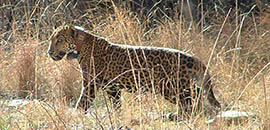This Arizona Game and Fish Department photograph shows a jaguar that was captured and outfitted with a tracking collar when it was snared in southern Arizona in 2009. The aged jaguar was later recaptured and euthanized after showed signs of kidney failure. (Arizona Game and Fish Department Photo)
By DIANGELEA MILLAR
Cronkite News Service
PHOENIX – The U.S. Fish and Wildlife Service has designated more than 1,100 square miles of southern Arizona and New Mexico as critical habitat for the endangered jaguar.
The announcement Tuesday means that federal agencies will have to consider the impact on jaguars before approving uses such as mining. The designation doesn’t apply to private land unless the owners propose a use requiring federal funding or permits.
“It serves as a yellow flag for federal agencies that now have an additional responsibility to protect the habitat,” said Jeff Humphrey, a U.S. Fish and Wildlife Service spokesman.
The designation includes mountain ranges in Pima, Santa Cruz and Cochise counties.
The jaguar, which is listed as an endangered species, once ranged from California into Louisiana. However, habitat destruction and hunting decimated the population.
Jaguars have been spotted occasionally in southern Arizona in recent years, including reports of one in the Santa Rita Mountains south of Tucson. In 2009, state Game and Fish Department employees snared an aged jaguar, dubbed Macho B, which died shortly after in captivity.
The Tucson-based Center for Biological Diversity sued the U.S. Fish and Wildlife Service three times seeking critical habitat protection for jaguars. In 2009, a federal judge in Arizona rejected the agency’s arguments against the designation, including the fact that few jaguars were believed to be in the U.S.
Despite Tuesday’s announcement, Michael Robinson, a conservation advocate for the center, said it isn’t enough.
“U.S. Fish and Wildlife Service has been very reluctant to take action with the jaguars,” he said. “We must regain the previous range to make and bolster the gene pool.”
Critical habitat area designations include the Baboquivari, Pajarito, Atascosa, Tumacacori, Patagonia, Santa Rita and Huachuca mountain ranges in Arizona, the Peloncillo Mountains that straddle the Arizona/New Mexico line and the northern tip of the San Luis Mountains in New Mexico.
Robinson said the designation should have included the Chiricahua Mountains in southeastern Arizona and the Mogollon Rim.
The designated habitats were decided after a team of scientists studied the North American jaguar population’s history and current habitat, which is mostly in Mexico, Humphrey said.
“We look at what’s biologically justifiable,” he said. “It allows movement for animals from that northern population.”
A jaguar recovery plan is set for release by U.S. Fish and Wildlife Service in the spring. Robinson said the plan should include a way to assist the jaguars in Mexico and possibly consider the idea of reintroduction.
Humphrey said there is no plan to reintroduce jaguars in Arizona, but he added that conservation of habitats once popular with the jaguar is important.
“If we conserve endangered species in their habitats today, it doesn’t give us room for conservation in the future,” Humphrey said.
Mike Rabe, nongame wildlife branch chief for the Arizona Game and Fish Department, said agency didn’t support designating critical habitat for the jaguar and doesn’t think doing so will make a difference.
“People get really excited about this, but the conservation impact of this will be slight,” he said.
“It’s not that we don’t like jaguars,” he added. “We’d like to see more of them in the state.”
CRITICAL JAGUAR HABITAT
The 764,207 acres designated as critical habitat for jaguars includes these mountain ranges:• Baboquivari
• Pajarito
• Atascosa
• Tumacacori
• Patagonia
• Santa Rita
• Huachuca
• Peloncillo Mountains straddling the Arizona/New Mexico line
• San Luis Mountains in New Mexico









No comments:
Post a Comment